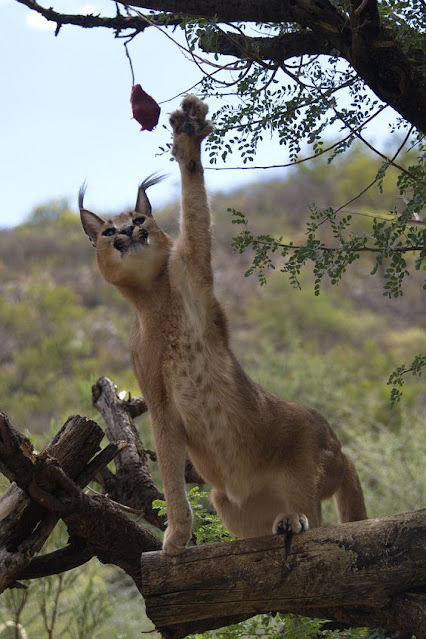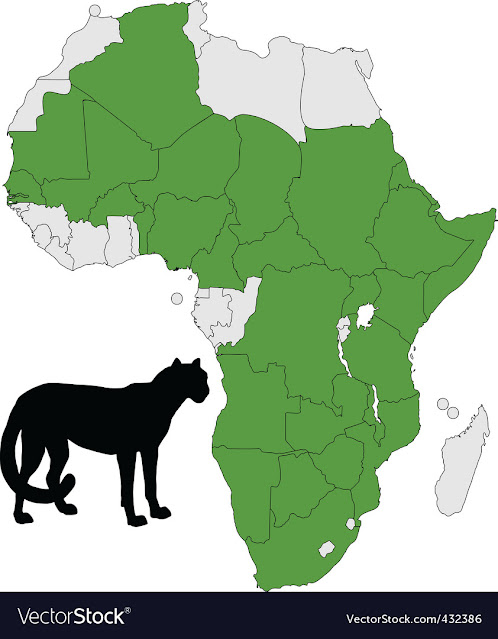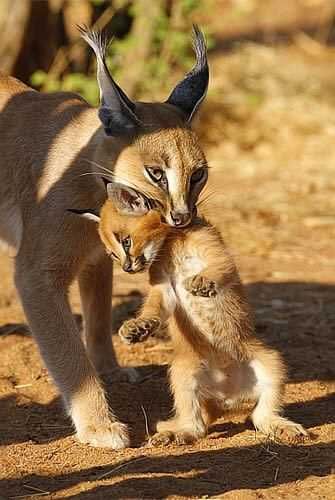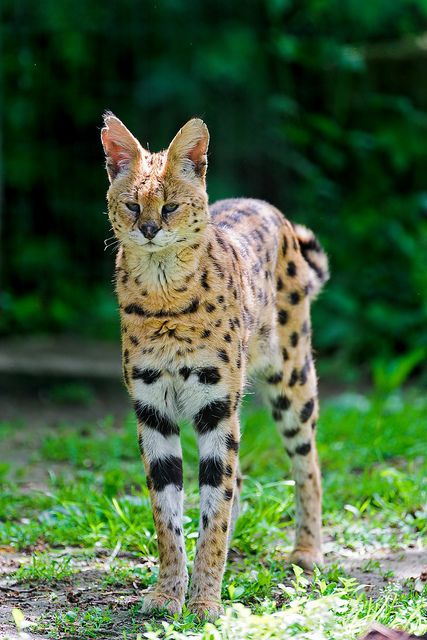.Head length: 45–80 cm (17–31 –80)
.Tail length: 24.1-36.8 cm (9.4-14-)
.Weight: 3-8 kg (6-18 lb)
The African wildcat Felis Libya is the size of a large housecat. They have longer legs than the domestic cat, giving them a more upright posture and a different walking form in the sitting position. The background color of its coat varies from red to sandy yellow to gray and is usually marked by pale tabby stripes and spots. Fairs have speckled black tips, and their legs are tied with black stripes. A distinctive feature of this group is a red or reddish-brown tint on the back of the ear. The long, thin tail ends with 2 or 3 black rings and a black tip. There is a line of deep fur down the spine from the shoulder to the base of the tail. The footpads are black like a cat with black legs. The African species distinguish it from European wildcats by its light build, less distinctive markings, and thin tapering tail.
This cat varies in appearance locally. In general, from north to south there is an order of coat thickness, the intensity of ground color, and the amount of "tabby" markings.
There are two main features that can help distinguish wild cats from domestic cats and hybrids. The back of one ear is rich in a reddish-brown color. Domestic-wild crosses usually have dark brown or black-backed ears, but sometimes remain slightly red at the base. The second striking feature is the wildcat's long legs. When the wildcat is seated upright, his long front legs raise his body in an almost vertical position. This characteristic pose, which is almost impossible for domestic cats or crosses, can be seen in ancient Egyptian bronze mummy cases and tomb paintings. It also gives a specific action when the wildcat has long legs and high shoulder blades running; It moves more like a leopard than a domestic cat.
Distribution:
This wildcat has a very wide distribution, found throughout Africa, Southwest and Central Asia in India, China and Mongolia. It is found in most parts of Africa and in the Caspian Sea around the periphery of the Arabian Peninsula. It is present in all East and South African countries. In North Africa, they are separated from Morocco via Libya in Algeria, Tunisia, and Egypt. In West Africa, it is widely distributed from Mauritania to the Horn of Africa, Sudan, and Ethiopia.
The African wildcat has a very wide habitat and it meets with grasslands to open in deserts, semi-deserts, savannas, hilly and rocky areas, as well as mixed forests. It seems to be absent only from the tropical rainforest. In the Nubian, Saharan, and Arabian deserts, it appears to be limited to mountains and dry springs. In Kenya, Ethiopia, and Algeria, it has been recorded at over 3,000 m altitude.
Ecology:
It is a solitary species, but may temporarily form large groups, with its offspring from several consecutive litters. It is primarily a nocturnal environment, especially in very hot environments or in proximity to inhabited areas but it can also be active in the early morning or late afternoon. It mainly hunts on land but is an excellent climber. It pursues its prey after a quick attack. Since wildcats mainly rely on rodents, which undergo large cyclic changes in populations, they must often be able to produce large litters to withstand the fluctuations of these prey base.
Wildcat is territorial and uses scent marks for communication. In the United Arab Emirates, a woman's home range of 52.7 km was much larger. In South Africa, a women's home range of 6–10 km G was recorded at Kalahari Ratna Park. The home range of a male African wild animal was 4.3 km male near Nakuru, Kenya.
The main prey species are rodents such as rats, mice, and volts. It also hunts insectivores, rabbits, rabbits, birds, insects, frogs, lizards, fish, and sometimes martyrs, weasels, polecats, and poultry. Wildcat can also hunt young antelope and small livestock (sheep, goat kits). It is also known as a scavenger.
Reproduction
The birth season in southern Africa is from September to March. In the Northern Sahara, breeding takes place from January to March. The gestation lasts 56–68 days and at 9–12 months the wildcat reaches its sexual maturity. When the female is in heat, it only allows one male in its territory. Longevity is up to 16 years.
Protection:
Hybridization with domestic cats is considered the main threat to wildcats. Evidence of such cross-breeding has been found in southern and northern Africa. Hybridization has been occurring for a long time, and it is possible that very few genetically pure African wildcats still exist. Pure genetic populations can only remain in protected areas away from human settlements. Wild domestic cats compete with wildcats for hunting and habitat. Wildcats can also suffer from diseases transmitted by domestic cats.
Wildcats are also killed by vehicles, as bycatch of predator control measures, or by rodents. In southern Africa, they are persecuted as pests due to predation of poultry and lambs.
If rodents are available then the wildcat can live in an agricultural or farming landscape dominated by humans. However, there are also habitats where hybridization occurs and spreads. Therefore, it is important to identify genetically pure African wildcats and assure their safety to prevent hybridization or disease from domestic cats. The difference between wild and domestic cats is however complex and difficult to assess, especially in the area.
An international studbook aims to record captive individuals of the subspecies distributed in Oman and the United Arab Emirates, Gordon's Wildcat (F. L. Gordon), a threat through the hybridization and human encroachment of the desert's environment.
The wildcat is included in Appendix II of the CITES but has not been preserved on much of its range in Africa. Wildcats (including Felis sylvestris and Felis labia) are considered to be list Concerns in the IUCN Red List of Threatened Species. Felis Libya species has not yet been separately evaluated in the IUCN Red List.
Updated 2018
Range Map Etiquette IUCN Red List
Thanks for reading our article:









0 Comments:
Post a Comment